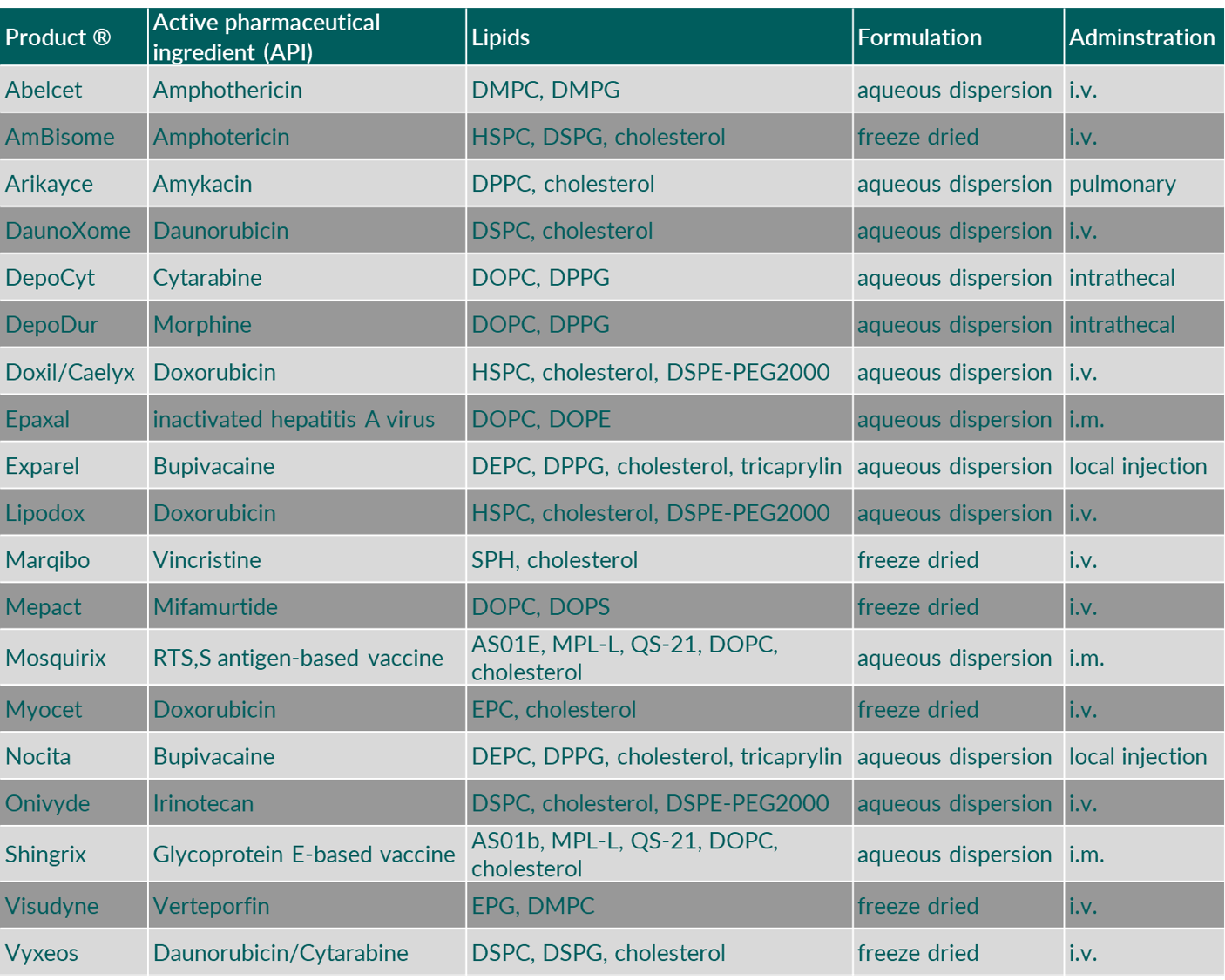Liposomes
Liposomes are used in pharmaceutical, nutritional, and cosmetic products. Their cell-like structure allows incorporation of hydrophobic, hydrophilic, as well as amphiphilic drugs. Moreover, liposomes are attractive as analytical tool, e.g., to mimic cells and isolated properties of them.
Learn more about liposomes, their characteristics and their applications in drug products and research here.
Per definition, liposomes are aggregates of phospholipids in water, in which the molecules form a phospholipid bilayer membrane surrounding one or more aqueous compartments. Lipophilic and amphiphilic actives can integrate within the bilayer, whereas hydrophilic actives can be incorporated in the aqueous core or between different phospholipid bilayers.
Liposomes enable administration of actives by solubilization and increase the therapeutic index of the encapsulated drug by optimizing its pharmacokinetic properties and/or pharmacodistribution. The phospholipid composition, as well as size and number of concentric lamellar phases per liposome are important parameters to consider with respect to their administration site and desired fate after administration.
Building blocks used for liposomes
Phospholipids, both natural and synthetic, along with cholesterol are the most common constituents of liposomes. The wide variety of phospholipids offers a versatile toolbox to modulate their characteristics. In addition, there is a number of further established and innovative excipients that allow to tune liposome characteristics.
- Natural phospholipids are rich in essential unsaturated fatty acids and therefore, typically exhibit phase transition temperatures below the body temperature.
- Hydrogenation of natural phospholipids results in phospholipids with exclusively saturated fatty acids. Therefore, their phase transition temperatures rises and they form a rigid gel state bilayer at body temperature.
- Synthetic phospholipids may introduce specific properties that cannot be found in natural phospholipids. A prominent example is the use of PEGylated phospholipids that endow liposomes with so-called “stealth” properties.
- Cholesterol is incorporated into the phospholipid bilayer and modulates the rigidity and stability of liposomes.
Pharmaceutical applications of liposomes
Commercially available liposomal products
Focusing on parenteral applications, liposomes and liposomal formulations of active pharmaceutical ingredients (API) play an outstanding role, which is due but not restricted to the introduction of Doxil®. Doxil (doxorubicin HCl for injection) was the first nano-drug approved by the US Food and Drug Administration (FDA) in 1995.1)
Examples of parenteral products with liposomes are provided in Table 2.

Table 2. Liposomal formulations approved in EU and US. (Abbreviations: DEPC, 1,2-dierucoyl-sn-glycero-3-phosphocholine; DMPC, 1,2-dimyristoyl-sn-glycero-3-phosphocholine; DMPG, 1,2-dimyristoyl-sn-glycero-3-phosphoglycerol; DOPC, 1,2-dioleoyl-sn-glycero-3-phosphocholine; DOPE, 1,2-dioleoyl-sn-glycero-3-phosphoethanolamine; DOPS, 1,2-dioleoyl-sn-glycero-3-phospho-L-serine; DPPC, 1,2-dipalmitoyl-sn-glycero-3-phosphocholine; DPPG, 1,2-dipalmitoyl-sn-glycero-3-phosphoglycerol; DSPC, 1,2-distearoyl-sn-glycero-3-phosphocholine; DSPE-PEG, 1,2-distearoyl-sn-glycero-3-phosphoethanolamine polyethylene glycol; DSPG, 1,2-distearoyl-sn-glycero-3-phosphoglycerol; EPC, egg phosphatidylcholine; EPG, egg phosphatidylglycerol; HSPC, hydrogenated soybean phosphatidylcholine; QS-21, Quillaja saponaria Molina, fraction 21)
Explorative liposomal formulations
Liposomes are extensively researched in industry and academia, e.g., to achieve highly specific targeting to cancer tissue or to improve their stability during oral administration. Also the PRC funds several projects that contribute to the knowledge about liposomes. Below you can learn more about the diverse research efforts.
Targeted liposomes
To enhance selectivity of drugs to target tissue, liposomes can be functionalized with ligands that specifically bind to cell subtypes of these tissues. Ligands like peptides, aptamers, antibodies or antibody fragments specifically bind to complementary moieties on cells that mediate liposome uptake. Most commonly, the ligand is chosen with regards to pathogenic cell types like cancer cells, but is also applied to surpass biological barriers like the blood brain barrier to treat otherwise unreachable cells.2)3)
Stimulus-responsive liposomes
Another strategy to enhance selectivity, is the release of the cargo specifically at the target site. For this purpose, liposomes that release their cargo by an external stimulus, can be applied. Common stimuli are mild hyperthermia,4) light,5) and radiation6) that are applied by an external source. However, also stimuli present in the body can be used to trigger cargo release. For example, mechanosensitive liposomes may be used to treat thrombi-related conditions like an ischemic stroke. With increasing shear stress at a constricted section of a blood vessel, these liposomes release their cargo where plaques are located.
Oral administration of liposomes
Due to the presence of bile acids, liposomes dissociate in the gastrointestinal tract. Moreover, phospholipids are hydrolyzed by phospholipases present in bile. The liposomal building blocks and their degradation products undergo re-arrangement during gastrointestinal passage with endogenous compounds and give rise to solubilizing vehicles like mixed mixelles.7)
To increase their stability, liposomes can be complemented with additional excipients. Tetraether lipids that are naturally found in archeae increase the stability of these organisms to low pH values and are applied to stabilize liposomes in the gastric environment.
Interested in further innovative applications of liposomes? Visit our funded projects to learn more about latest research in this field.
You want to know more about phospholipid-based formulations?
Please use the following links:
Which applications exist for phospholipid-based emulsions?
How are mixed micelles formed and applied?
What role do phospholipids play in lipid nanoparticles (LNPs)?
Towards clinical translation of ligand-functionalized liposomes in targeted cancer therapy: Challenges and opportunities
J. Controlled Release 277
| PubMed |
Strategies for delivering therapeutics across the blood–brain barrier
Nat. Rev. Drug Discovery 20 (5)
| PubMed |
Triggered release from thermosensitive liposomes improves tumor targeting of vinorelbine
J. Controlled Release 354
| PubMed |
Light-activated liposomes coated with hyaluronic acid as a potential drug delivery system
Pharmaceutics
| PubMed |
Controlled gene and drug release from a liposomal delivery platform triggered by X-ray radiation
Nat. Commun. 9 (1)
| PubMed |

